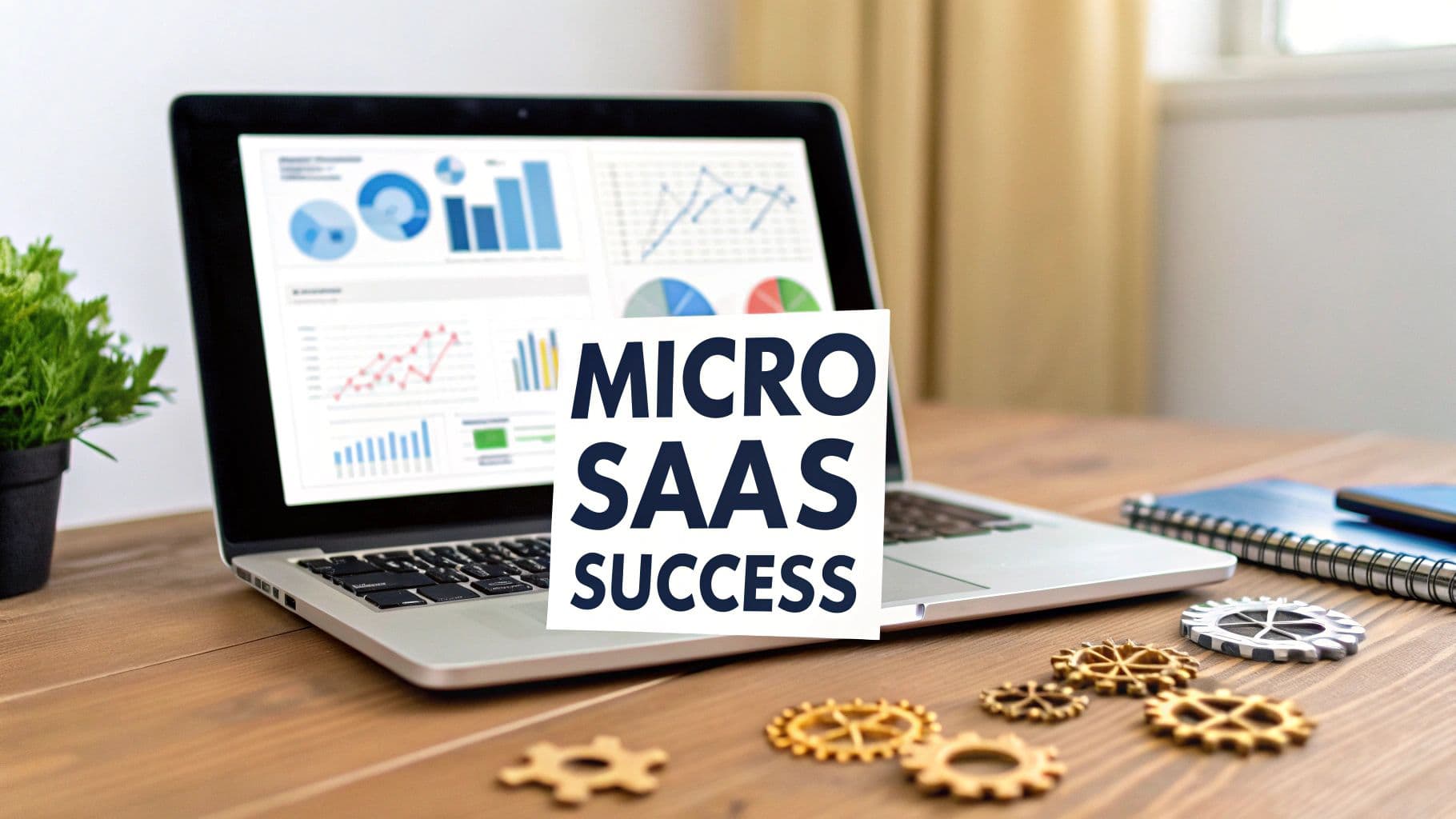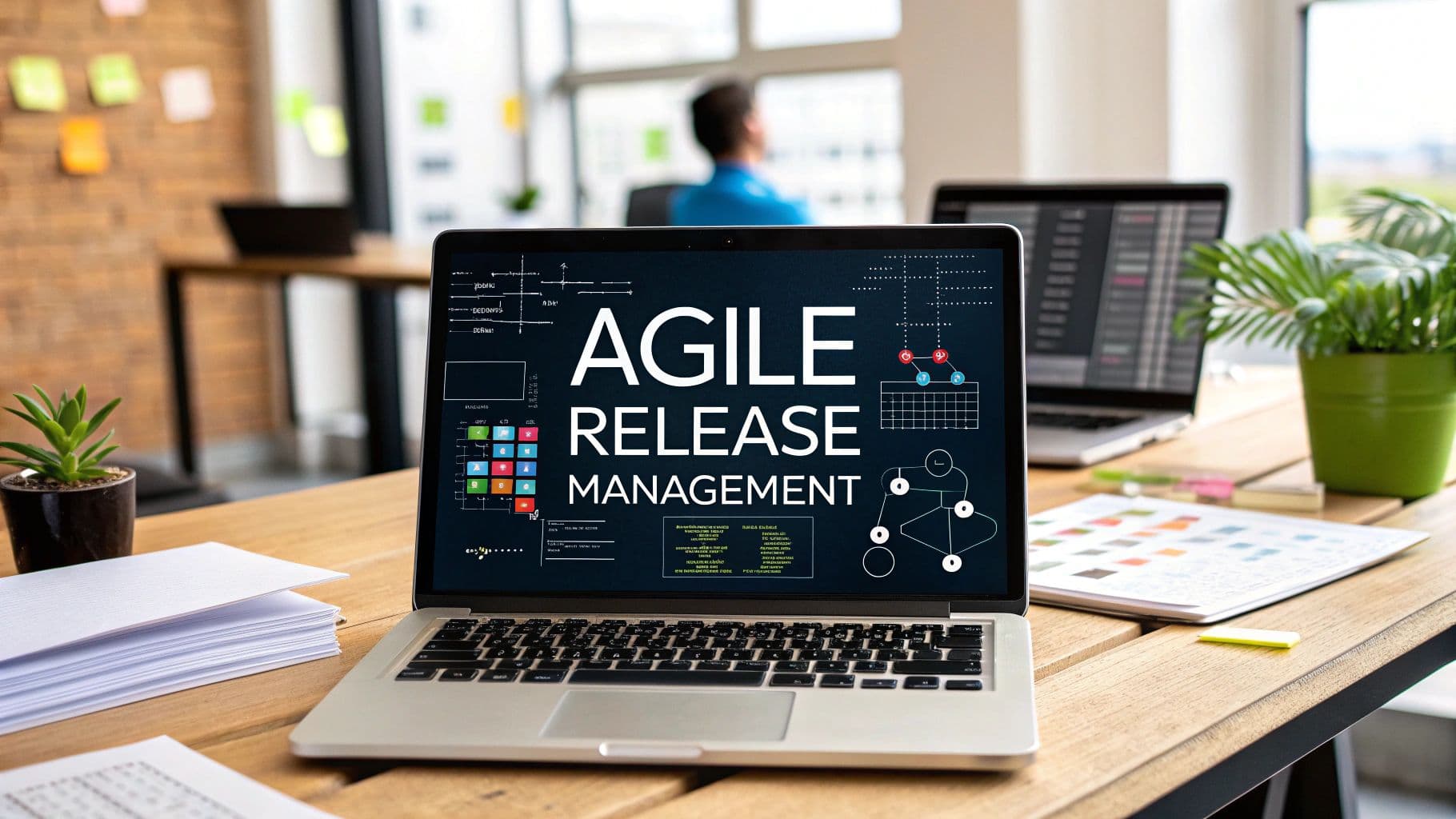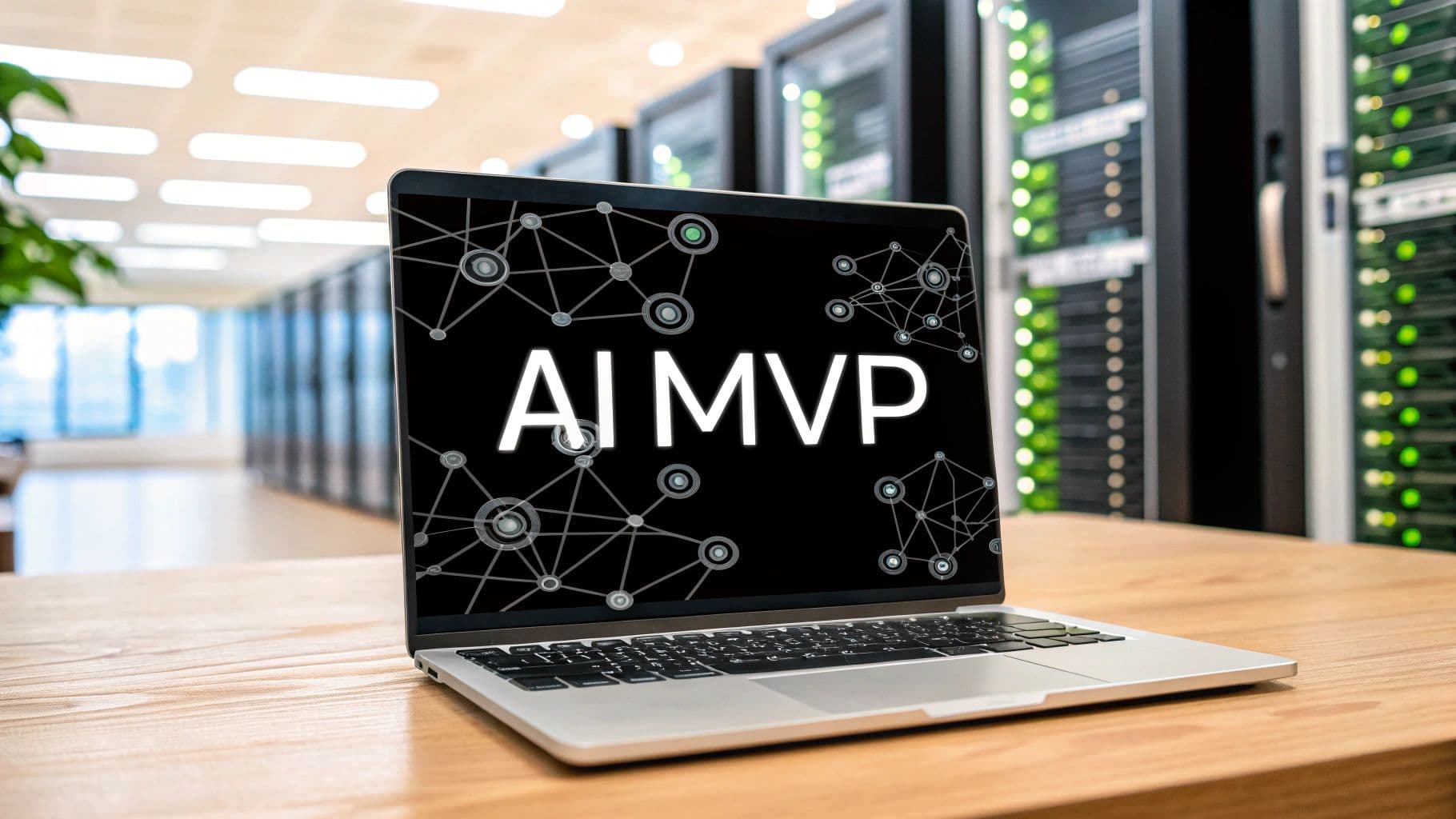micro saas
bootstrapped business
saas development
niche software
profitable saas
How to Build a Micro SaaS: A Complete Guide for Success
The Micro SaaS Opportunity: Why Now Is the Perfect Time

Micro SaaS businesses offer a compelling alternative to the traditional, venture-capital-fueled SaaS model. They prioritize profitability over rapid growth, often focusing on a specific niche with a small team or even a solo founder. This lean approach allows for greater flexibility, control, and a quicker path to revenue generation. But why is now the opportune moment for this model?
The Rise of Niche Markets
The internet has significantly lowered the barrier to entry for reaching niche audiences. Connecting with a small, specialized group was once expensive and inefficient. Now, tools like targeted advertising, online communities, and specialized content platforms make it easier than ever. This empowers micro SaaS founders to build highly engaged user bases around specific needs.
For example, a micro SaaS could be built for project managers in the construction industry or for Etsy Etsy sellers specializing in handmade jewelry. These focused solutions address very specific pain points that larger, more generalized software might overlook.
The Power of Lean Operations
Micro SaaS ventures are built on efficiency. Low overhead and minimal staffing translate to higher profit margins, allowing founders to bootstrap their businesses and retain control. The ability to quickly iterate based on direct user feedback is also key, leading to continuous improvement and a stronger product-market fit. This tight feedback loop is a significant advantage.
Exploding SaaS Market Growth
The overall SaaS market's explosive growth provides fertile ground for micro SaaS businesses. Understanding broader SaaS market trends is key to building a successful micro SaaS. The global SaaS market has seen tremendous growth, projected to rise from $197 billion in 2023 to roughly $299 billion by 2025.
This growth is driven by factors like increased enterprise adoption, AI integration, and evolving pricing models. For micro SaaS, focusing on niche markets becomes crucial, allowing them to thrive by targeting specific user needs within these larger industries. By 2023, 99% of businesses used at least one SaaS solution. Learn more about this trend here.
This widespread adoption demonstrates the potential for smaller, specialized solutions. The increased accessibility of tools and resources further lowers the technical hurdles for individuals to launch their own micro SaaS ideas.
Finding Your Profitable Niche: Beyond Surface-Level Ideas
Identifying a profitable niche is the cornerstone of a successful micro SaaS business. It's not enough to simply have an idea; you need to validate that there's a genuine market need and a willingness to pay for a solution. This involves moving beyond surface-level brainstorming and diving deep into understanding specific user pain points.
Identifying Underserved Needs
One effective method for uncovering promising niches is to identify automation opportunities within familiar industries. Think about repetitive tasks or processes that could be streamlined with software. For example, a micro SaaS could automate report generation for marketing agencies or simplify inventory management for small e-commerce businesses.
Additionally, leveraging online communities can be invaluable. Browse forums, social media groups, and Q&A sites like Reddit and Quora to pinpoint recurring problems or frustrations within specific communities. These platforms offer a wealth of unfiltered insights into user needs and desires.
You might be interested in: 10 Micro SaaS Opportunities for Indie Hackers
Validating Market Demand
Before investing time and resources in development, it's essential to validate your niche idea. Conducting customer interviews is a powerful way to gauge true market demand. Focus on understanding the specific pain points your potential users face and how much they would be willing to pay for a solution that addresses those problems.
Remember, what people say they want and what they will actually pay for can be very different. This research will help you refine your idea and ensure you're building something people genuinely need.
Another key factor to consider is whether your target users have both the pain and the budget to justify your solution. A clear pain point might exist, but if the potential user base lacks the financial resources to invest in a solution, it won't be a viable business opportunity. This leads to a critical decision-making process:

This decision-tree infographic outlines the key factors to consider when assessing a micro SaaS niche. If market demand is high and competition is low, proceed to building your minimum viable product (MVP). However, if either demand is low or competition is high, it's essential to refine your idea.
The Micro SaaS Market Landscape
The Micro-SaaS market itself holds significant promise. It's forecasted to reach approximately $55 billion by 2026. This potential stems from the inherently lean nature of Micro-SaaS businesses. They operate with minimal overhead, allowing for higher profit margins and quicker paths to profitability—often within 1-2 years.
This is largely due to their targeted marketing strategies and lower operational costs. Successful Micro-SaaS companies often see high customer retention rates because their specialized solutions cater directly to user needs. Find more detailed statistics here.
For those interested in building and selling a micro-SaaS, it's inspiring to learn from founders who have already navigated this path. Consider this case study: micro-SaaS product without a team
The following table provides a framework for evaluating potential Micro SaaS niches:
Micro SaaS Niche Evaluation Framework
A structured approach to evaluating potential Micro SaaS niches across key dimensions
| Evaluation Criteria | Strong Potential | Moderate Potential | Weak Potential |
|---|---|---|---|
| Market Demand | High search volume, active online communities discussing the problem | Moderate search volume, some online discussion | Low search volume, little online discussion |
| Competition | Few existing solutions, underserved market | Some competitors, but room for differentiation | Many established competitors, difficult to stand out |
| Monetization Potential | Clear willingness to pay, potential for recurring revenue | Some indication of willingness to pay, potential for one-time purchases | Unclear willingness to pay, difficult to monetize |
| Target Audience | Clearly defined, easily reachable | Somewhat defined, requires more research | Difficult to define and reach |
This framework highlights the key areas to focus on when assessing a niche. Strong potential niches exhibit high demand, low competition, and a clear path to monetization.
Finding the right niche requires careful research, validation, and a deep understanding of your target audience. By focusing on underserved needs and validating market demand before building, you’ll significantly increase your chances of creating a successful and sustainable micro SaaS business.
Building Your MVP: From Concept to First Paying Customer
Forget striving for perfection right out of the gate. The minimum viable product (MVP) is all about speed and efficiency. It's about getting a functional product into the hands of your target audience quickly to address their core needs. Successful micro SaaS founders understand this, prioritizing early value delivery and iterating based on real user feedback.
Prioritizing Core Features
The heart of a successful MVP lies in ruthless feature prioritization. It's easy to get caught up in adding every bell and whistle, but resist that temptation. Focus exclusively on the essential features that deliver the core value of your micro SaaS. This focused approach not only speeds up development but also allows you to gather crucial feedback on what truly matters to your users.
For example, imagine building a micro SaaS for scheduling social media posts. Your MVP might only include basic scheduling functionality for a single platform, like Twitter. Advanced features, such as analytics or multi-platform support, can be added later based on user demand.
Before investing significant time and effort, validate your business idea. This is a crucial step in ensuring you're building something people actually want. Validate your business idea.
Rapid Development Strategies
Whether you're a coding whiz or a non-technical founder, there are development strategies tailored to your skillset. Seasoned developers can leverage tools and frameworks like SaaS boilerplates to accelerate the development process. Non-technical founders can explore no-code platforms like Bubble or partner with developers to bring their vision to life. The goal is to build a functional product quickly, not a perfect one. Embrace imperfection and prioritize getting your MVP into the hands of real users as soon as possible.
Gathering User Feedback and Iterating
Launching your MVP is just the first step. Gathering actionable user feedback is essential for refining your product and achieving product-market fit. Implement systems for collecting feedback, such as in-app surveys, user interviews, and tools like Hotjar for tracking user behavior.
This feedback loop is the engine of growth for your micro SaaS. Use the insights gathered to prioritize further development and iterate quickly. This iterative process ensures continuous product improvement and alignment with the evolving needs of your target audience.
Recognizing Product-Market Fit
As you iterate based on user feedback, you'll begin to see indicators of product-market fit. This means your product resonates with your target audience and solves a real problem for them. These indicators can include strong user engagement, positive feedback, and organic growth.
Recognizing product-market fit is a significant milestone. It signals that you've built something valuable and are ready to scale your efforts. This might involve expanding your marketing efforts, adding new features, or exploring pricing strategies to maximize revenue growth. Building an MVP is a continuous journey of learning, adapting, and refining your product based on real-world usage.

Pricing Strategies That Maximize Revenue and Growth
Pricing your micro SaaS effectively is crucial for attracting customers and maximizing revenue. It's not just about assigning a price; it involves understanding your target market, their perceived value of your product, and the competitive SaaS landscape.
Understanding Value-Based Pricing
Value-based pricing focuses on the value your micro SaaS offers, not just your costs. This involves understanding the problem you solve and how much that solution is worth to your target audience. For example, if your micro SaaS saves users 10 hours of work monthly, calculate the financial value of that time saved and price accordingly. This often yields higher profit margins than simply marking up costs.
Tiered Pricing Structures and Freemium Models
Tiered pricing offers different service levels at different price points, catering to a broader customer range, from those needing basic features to those requiring more advanced capabilities. A simple structure might include a basic, standard, and premium plan, each with increasing value and features.
A freemium model, on the other hand, provides a free version with limited functionality, along with paid premium tiers. This lets potential customers experience your product's value before subscribing. Make sure your free tier is attractive enough to draw in users but limited enough to encourage upgrades.
You might be interested in: Learn more in our article about Stripe vs. Lemonsqueezy for SaaS
Price Anchoring and Value Ladders
Price anchoring strategically positions different pricing tiers to influence customer perception. A high-priced premium tier next to a lower-priced standard tier makes the standard tier seem more appealing, significantly impacting buying decisions.
Creating a value ladder involves clearly outlining the increasing benefits at each price point. Each tier should offer progressively more value, justifying the price increase and reinforcing your micro SaaS's perceived worth, encouraging upgrades.
Implementing Controlled Pricing Experiments
Testing different pricing strategies is essential for finding what works best. Conduct A/B testing on various pricing structures, tiers, and messaging to gauge the impact on conversion rates and revenue. This data-driven approach allows you to optimize pricing over time and maximize profitability.
Communicating Value Effectively
Communicating the value you deliver is key, especially in a competitive market. Don't just list features; explain their benefits and how they solve user problems. Quantify the value whenever you can, using metrics like time saved, money earned, or efficiency gains. Demonstrating your value avoids competing solely on price and justifies a premium strategy.
Micro SaaS success depends on understanding market trends. The global SaaS market is expected to reach $1,251.35 billion by 2034, driven by cloud adoption and technological advancements. Understanding these trends helps micro SaaS businesses capitalize on emerging opportunities. Find more detailed statistics here. Effective pricing is an ongoing process requiring continuous analysis, experimentation, and adaptation.
Customer Acquisition That Works Without Deep Pockets

Building a thriving micro SaaS doesn't require massive ad spends or huge marketing teams. Instead, success hinges on smarter, more focused customer acquisition strategies. This section explores budget-friendly methods ideal for bootstrapped founders, emphasizing genuine connections and real value for your niche audience.
Content Marketing For Authority Building
Becoming a recognized expert in your niche is a powerful way to attract customers organically. Creating high-quality content like blog posts, tutorials, and webinars that addresses your target audience’s needs and pain points is key. This approach provides valuable information while subtly showcasing your expertise and the benefits of your micro SaaS.
For example, if your micro SaaS helps Etsy sellers manage inventory, focus your content on inventory best practices or Etsy sales strategies. This establishes you as a helpful resource, building trust and driving traffic to your site.
SEO: Targeting High-Intent Keywords
While large competitors may focus on broad keywords, micro SaaS businesses can gain a significant edge by targeting specific, long-tail keywords. These keywords reflect the precise needs of your ideal customer, leading to higher conversion rates. Consider the specific questions your target customer would type into a search engine.
Tools like Ahrefs and Semrush can help identify relevant keywords with low competition. This targeted approach proves far more effective than competing for generic, high-volume terms.
Community Building and Word-of-Mouth Growth
Nurturing a strong community around your micro SaaS is crucial for organic growth and valuable feedback. Engage with potential customers in online forums, social media groups, and relevant online communities.
Direct interaction builds relationships, fosters brand loyalty, and generates authentic word-of-mouth marketing. This can be a highly effective, low-cost acquisition strategy.
Permission-Based Email Marketing
Email remains a potent tool for lead nurturing and conversion. Build your email list by offering valuable content like free ebooks or exclusive insights in exchange for email addresses.
Use permission-based email campaigns to educate subscribers about your micro SaaS, share helpful tips, and promote relevant offers. This allows you to connect directly with potential customers.
Strategic Partnerships
Collaborating with complementary businesses can significantly expand your reach and introduce your micro SaaS to a wider audience. Identify partners whose products or services align with your target market.
These partnerships might involve joint ventures, co-marketing campaigns, or affiliate programs, offering access to new customer bases.
Optimizing The Onboarding Process
First impressions are critical. A smooth, intuitive onboarding experience is essential for turning trial users into paying customers. Clear guidance, helpful tutorials, and responsive support during the initial stages of using your micro SaaS can significantly impact customer retention and satisfaction.
Measuring Acquisition Costs and Lifetime Value
Tracking your customer acquisition cost (CAC) against your customer lifetime value (LTV) is crucial for informed marketing decisions. Understanding these metrics helps optimize your marketing spend, pinpoint profitable channels, and ensure sustainable growth. A healthy LTV:CAC ratio, typically 3:1 or higher, is a key benchmark.
The following table summarizes the key characteristics of different marketing channels for micro SaaS businesses.
Micro SaaS Marketing Channel Comparison
Analysis of different marketing channels based on effectiveness, cost, and scalability for Micro SaaS businesses
| Marketing Channel | Average Cost | Time Investment | Scalability | Best For |
|---|---|---|---|---|
| Content Marketing | Low | High | High | Building authority, organic traffic |
| SEO | Low | High | High | Long-term growth, targeted reach |
| Community Building | Low | High | Moderate | Brand loyalty, word-of-mouth |
| Email Marketing | Low | Moderate | High | Nurturing leads, direct communication |
| Paid Advertising | Moderate to High | Low to Moderate | High | Rapid growth, targeted campaigns |
| Partnerships | Low to Moderate | Moderate | Moderate | Expanding reach, accessing new audiences |
By prioritizing these cost-effective strategies, micro SaaS founders can cultivate a thriving customer base without overspending. These methods emphasize building relationships, delivering value, and targeting efforts strategically for maximum impact.
Scaling Operations Without Sacrificing Your Sanity
Launching your micro SaaS is a huge achievement, but the real work begins after launch. Building operational systems that support long-term success without leading to burnout is essential. This involves implementing efficient processes, prioritizing your time effectively, and making informed decisions about growth.
Streamlining Customer Support
Providing top-notch customer support is vital for any business, especially a SaaS. However, it can quickly become overwhelming as your user base expands. Creating efficient systems is the key to maintaining high customer satisfaction without burning yourself out.
One effective strategy is developing a comprehensive knowledge base or FAQ section. This empowers users to find answers to common questions independently, reducing the number of direct support requests you need to handle.
Additionally, consider using help desk software like Zendesk to manage inquiries. Help desk software can automate responses, track conversations, and prioritize urgent requests, ensuring no customer is overlooked.
Automating Repetitive Tasks
Running a micro SaaS involves many repetitive tasks like billing, email marketing, and social media management. Identify these tasks and explore tools that can automate them. Automation tools like Zapier free up valuable time, allowing you to focus on more strategic activities like product development and long-term planning.
For example, you could automate welcome emails to new users, schedule social media posts, or implement a recurring billing system. This not only saves time but also ensures consistent execution of these important tasks.
Managing Technical Debt
As your micro SaaS evolves, technical debt can quickly accumulate. Technical debt refers to the implied cost of rework caused by choosing an easy (but not optimal) solution instead of a better approach that might take longer. Regularly reviewing your codebase, refactoring inefficient code, and prioritizing important updates are essential for maintaining a healthy and scalable product.
Think of managing technical debt like routine car maintenance. Addressing small issues proactively prevents larger, more costly problems down the road.
Making Your First Hire
Knowing when to hire your first employee is a critical decision. Consider factors like increasing support tickets, growing technical debt, or the need for specialized skills you may not possess. A well-timed hire can dramatically increase your productivity and free you to focus on strategic growth.
Implementing Robust Financial Management
Solid financial management is paramount for any business, especially in the SaaS world. Utilize accounting software like Xero or QuickBooks to track income and expenses, generate reports, and manage invoices. This provides invaluable insights into your financial health and helps inform decisions about pricing, marketing, and future investment.
Tracking Key Performance Indicators (KPIs)
Monitoring key performance indicators (KPIs) is critical for understanding your business's health. Metrics such as monthly recurring revenue (MRR), churn rate, and customer lifetime value (LTV) offer critical data. This data reveals growth trends, identifies potential problems, and highlights areas for improvement. These metrics are your business's vital signs, offering important insights into its overall performance.
By implementing these strategies, you can effectively scale your micro SaaS operations without burning out. Remember, building a sustainable business requires prioritizing both your product’s growth and your own well-being.
From Side Project to Sustainable Business: The Path Forward
Building a micro SaaS isn't just about launching a product. It's about creating a sustainable business aligned with your long-term goals. This means carefully considering your growth trajectory, building systems that minimize founder dependence, and constantly adapting to the changing market.
Defining Your Vision for Success
Not every micro SaaS founder aims to build a massive company. Some intentionally stay small and focused, prioritizing lifestyle and work-life balance over rapid expansion. Others choose to strategically scale, expanding product lines or entering new markets. Defining your vision of success is the first step. What do you ultimately want to achieve with your micro SaaS?
Building Recurring Revenue Streams
The power of the SaaS model lies in its recurring revenue. This predictable income provides stability and allows for long-term planning. Focus on building a loyal customer base through exceptional product value and customer support. Consider pricing strategies like annual subscriptions to improve cash flow and encourage long-term commitment.
Creating Systems for Independence
As your micro SaaS grows, reducing your daily operational involvement is critical. This involves documenting processes, automating tasks, and building a reliable team. Think of your micro SaaS as a well-oiled machine designed to function smoothly, even without your constant supervision. This allows you to focus on high-level strategy and growth.
The Decision to Retain or Sell
Many micro SaaS founders eventually face the decision to retain or sell their business. There’s no single correct answer; the best path depends on individual circumstances and goals. Selling can provide a substantial financial gain, while retaining allows you to continue nurturing your creation. Carefully weigh the pros and cons of each option.
Preventing Burnout and Maintaining Balance
Building a successful micro SaaS requires dedication and effort, but it shouldn't come at the expense of your well-being. Setting clear boundaries, prioritizing self-care, and taking breaks are essential for preventing burnout and maintaining a healthy work-life balance. A sustainable business supports your life, not consumes it.
Adapting to Market Evolution
The tech world is constantly evolving. Staying ahead requires continuous learning, adapting to new technologies, and anticipating market trends. Keep an eye on emerging technologies and be prepared to adjust your strategies as needed. Adaptability is key to long-term success in the SaaS world.
Building a sustainable micro SaaS is a journey. By focusing on your vision, building strong foundations, and constantly adapting, you can create a thriving business that aligns with your personal definition of success.
Ready to accelerate your micro SaaS journey? AnotherWrapper provides the tools and resources you need to launch your AI-powered project in hours, not weeks. Check it out now!
Fekri




